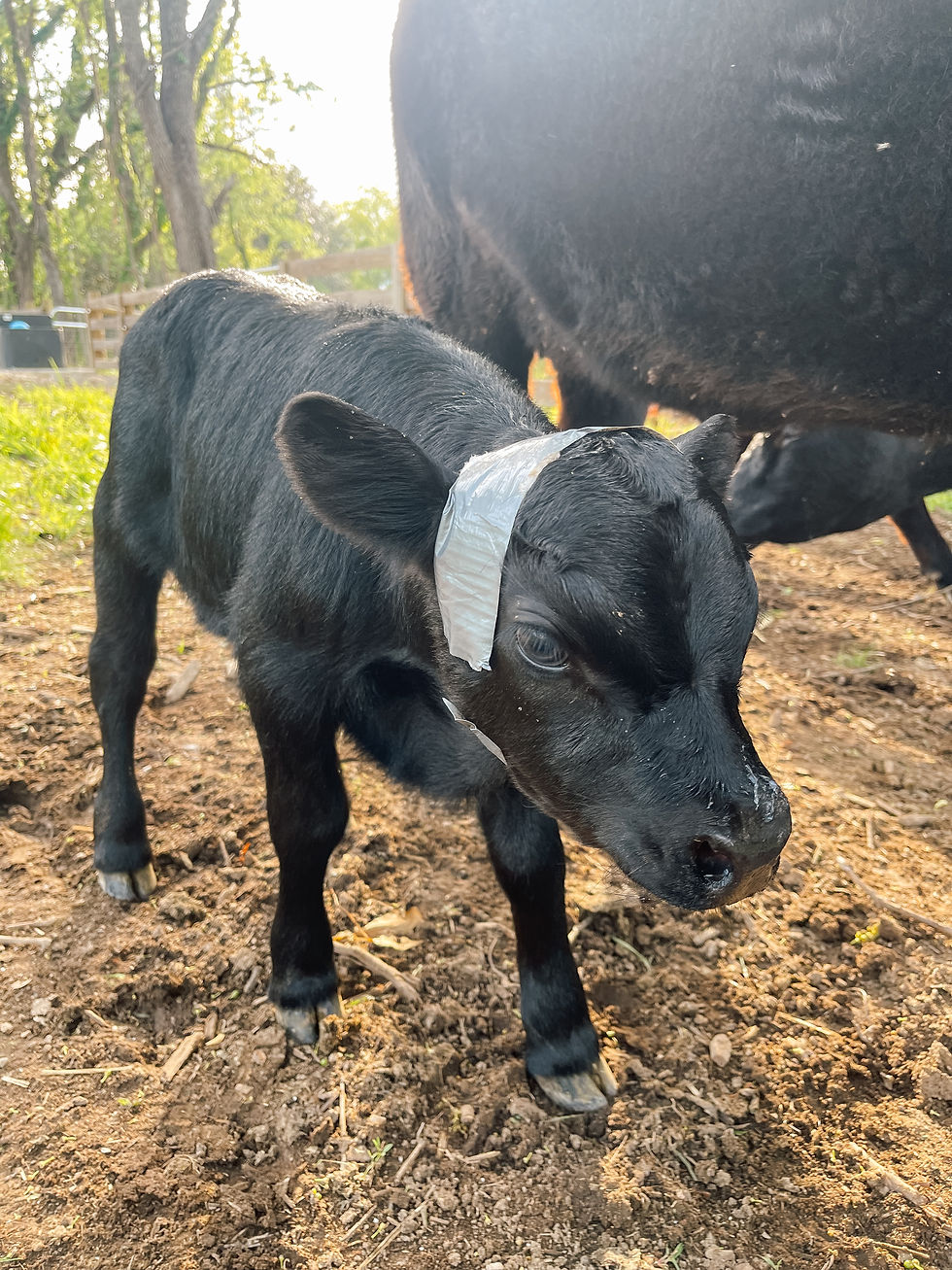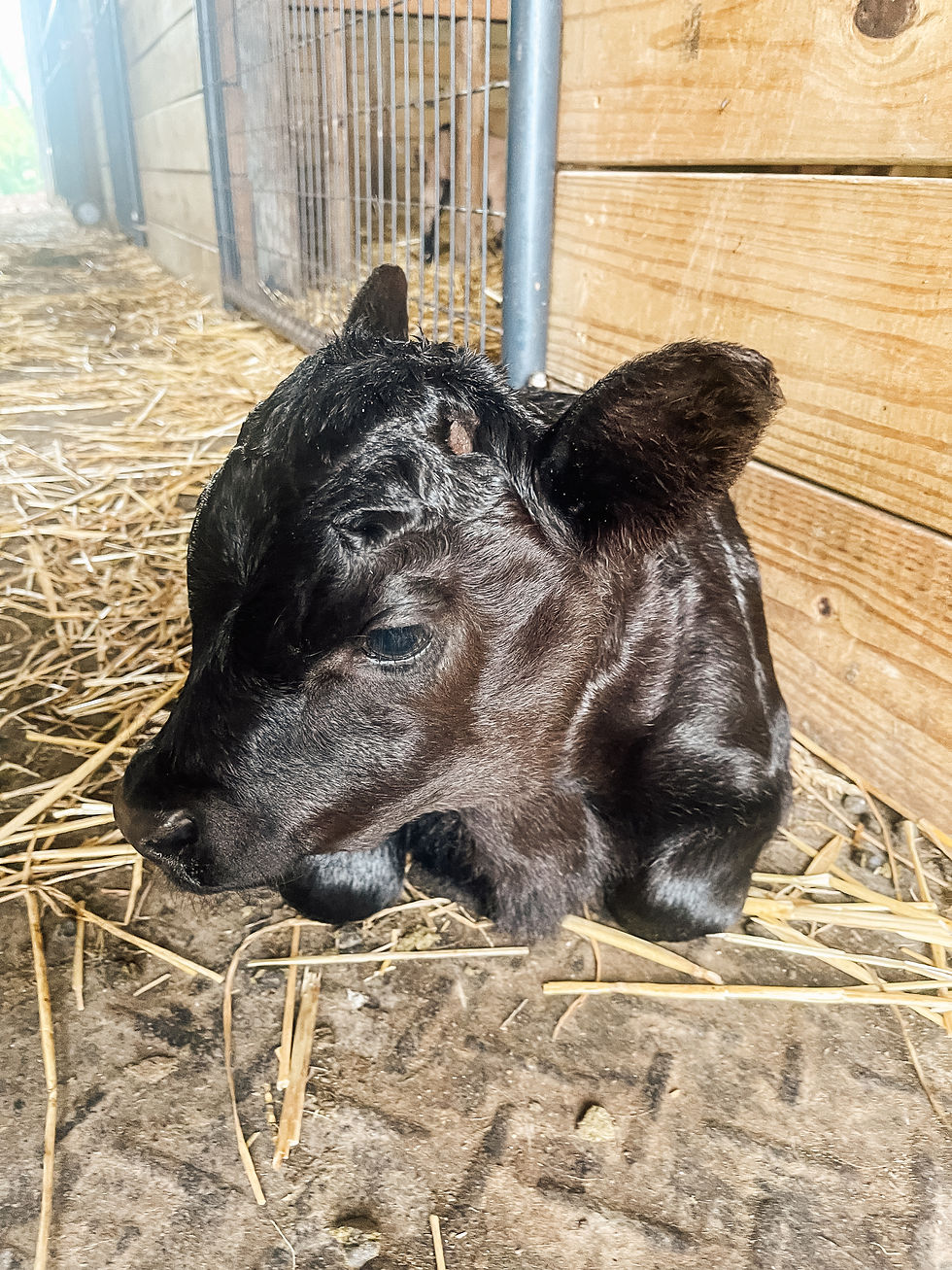I thought I would start a mini serious entitled "What Happens When". I realized that there are so many things that we do in the background that have become second nature, but to new or aspiring farmers this information could be helpful. What a wonderful opportunity to share our process and a little behind the scenes of our farm management and animal care.
To kick off the series why not share our process after a calf is born on the farm. As y'all know our mama Madeline recently had the sweetest little heifer calf. Madeline and Magnolia are both doing great. The first few days we keep a close eye on mama and calf to ensure they are both healthy and there are not signs for concern. So let's dive into what we watch for.

Things We Watch For
Mama Cow
Placenta- We always want to ensure the placenta is passed within 12 hours of calving, if not we call the vet. If the placenta is retained, the cow runs the risk of infection and in the worst case scenario the infection can lead to fertility issues in the future.
Facilities- The nice way of saying we maker sure she doesn't have any issues peeing or pooping.
Milk Fever- The Mama cow is most at risk right after delivery due to a rapid extraction of calcium. If this occurs the cow will be sluggish, have a low body temperature, decreased appetite, and often have issues standing. If not treated this can be fatal.
Udder Condition/Mastitis- Since we keep mama and calf together we keep a close eye on their udders for the first few weeks. Sometimes the calf can't keep up with the milk production and we will need to milk her out. A cow can get mastitis any time, but are most susceptible a couple weeks before and after calving and then again during the first few weeks of the dry period.

Calf
Anatomy- We check the calf for any obvious abnormalities or anything that would cause great concern. This would be things like a cleft palate or nose, extra teats, water belly, missing or abnormal limbs, or joint abnormalities. While we are checking over the calf, we also check gender.
Ability to nurse- It is crucial for the calfs health that they get colostrum within the first 4 hours, ideally within the first 30 minutes. You'd be amazed at how quickly these calfs can get up on their wobbly legs and find their way to the teat. We always stay with the calf until we have seen them successfully latch a few times and know that they have received enough colostrum. Honestly, we check on them several times a day to ensure they are still nursing adequately. We probably check too often, but we love our babies.
Facilities- Again a nice way to put that we check that they are able to poop and pee without any issues.
Gait- That's just a fancy medical word for how they walk. Checking their joints once again to make sure they can move around normally. We also don't want to see a decline in their strength.
Animal Care
After we have checked all the boxes for mama and calf we start planning for the care items needed. We have always brought mama and calf to the barn for the first night. This gives mama time to rest without the whole farm bothering them. We let mama decide how long they stay in the moo-ternity stall. Madeline is typically ready to rejoin the herd after one night but Trexy as a first time mama opted for a two night stay. We just let them decide. We do this by just leaving the stall door open and walking away. If they get their calf up and leave, we let them rejoin the herd. If they stay in the stall or walk away from the door, we know they aren't quite ready and try again later.
Mama really just needs extra love and access to fresh hay and clean water. We typically have the stall ready as soon as we know labor is starting, so the only thing we need to worry about is the cows and not mucking/preparing the stall. We do wait to put the bedding down because we don't want to waste it, but that takes just a few minutes.

The calf will receive a FirstDefense bolus that will help protect it against scours. We give this bolus within 12 hours of birth. We will also use an iodine spray of the umbilical area which will help reduce the chance of infection through the umbilical. As mentioned earlier, we continue to encourage nursing and ensure the calf doesn't have any issues getting that much needed colostrum.
Once the calf is 3 days old we will dehorn them. This can be done anywhere from day 3-5, but we try to aim for day 3. It is not recommended to use the dehorning paste after day 5. Our mentor and friend sent us this amazing dehorning process and it has worked great for us.
DEHORNING PROCESS
Step 1: Gather supplies
Duck Tape
Cotton Rounds
Wooden popsicle sticks (any disposable applicator will work)
Disposable gloves
Electric razor or beard trimmer (just borrow your husband's)
Dehorning Paste (linked the one we use, but we get it at our local co-op)
A helper- you could do this solo but we recommend that you have someone holding the calf while you apply the paste

Step 2: Get your calf. It's always best to separate mama for this part, just so no one gets hurt. Mama cows don't mess around. Once you are safely with your calf and your helper, shave the calfs horn bud areas. Feel for the little bumps on either side of the head. You don't need to shave a large area, just enough to expose the two horn buds.

Step 3: Make sure your helper has a good hold on the calf. Usually at this age they just curl up on your lap and fall asleep. Since the paste will burn anything it touches be very sure that the calf's head doesn't move around while the paste is applied.
Step 4: Have two cotton rounds set aside. Put on disposable gloves. Using the wooden applicator apply a pea sized amount of dehorning paste to each bud and just a little bit around it. A little goes a long way! We learned that the hard way with Tiergan. So after the paste is applied, place one cotton round on each horn bud/paste area. This will prevent the paste from getting on anything else.
Step 5: Wrap a piece of duck tape around the calfs head to hold the cotton rounds in place. Be sure to tell the calf how cute they are with their new headpiece. The duck tape/cotton round combo allows calf to be with mama without the risk of the paste harming her udder.

Step 6: Put the calf back with mama.

Step 7: About 2-3 hours later, remove the duck tape and cotton rounds. Don't wipe, touch, or wash the area.
We have used this process on all the calves born on our farm and so far, no regrowth or issues.

If we have a bull calf we will castrate sometime within the first 3 months of age. Since we do not have the acreage to keep a bull on farm, we opt for steers so we can raise them for meat (Steer is the term for a castrated bovine). Last year our neighbor walked us through the process with Tiergan and it was surprisingly simple. The next bull calf born on the farm, he will have Jordan do the procedure while he is there as a guide. If you're real adventurous you can cook up those Rocky Mountain Oysters and enjoy a tasty treat.

I hope this glimpse into our farm process was helpful and you learned something along the way. If there is a certain situation or farm scenarios you would like to hear about in our "What Happens When" series, please let us know and we would love to share it here.







Very informative I love seeing you with these animals and watching how they look at you with such affection because you guys have provided them with such a love filled life so proud of you guys